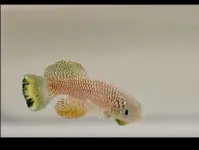(Press-News.org) The African turquoise killifish lives in ephemeral ponds in Zimbabwe and Mozambique. To survive the annual dry season, the fish’s embryos enter a state of extreme suspended animation or “diapause” for approximately 8 months. Now, researchers have uncovered the mechanisms that enabled the killifish to evolve this extreme survival state. They report May 30 in the journal Cell that although killifish evolved diapause less than 18 million years ago, they did so by co-opting ancient genes that originated more than 473 million years ago. Through comparative analysis, the team showed that similar specialized gene expression patterns are also employed by other animals—including the house mouse—during diapause.
“The whole program is like day and night—there is life in the normal state and life in the diapause state, and the way this happened was by reshuffling or re-wiring the regulatory region of a whole set of genes,” says senior author and molecular biologist Anne Brunet (@BrunetLab) of Stanford University.
African turquoise killifish mature faster than any other vertebrate species, and adults live for only around 6 months, even in captivity. The fish reproduce rapidly before their watery homes disappear, but their embryos remain behind in the dry mud, ready to hatch when the next year’s rains come. Embryonic diapause also occurs in other vertebrate species, including fish, reptiles, and some mammals, but killifish diapause is remarkably extreme because it lasts for such an extended period (8 months on average and up to 2 years in the lab) and because killifish embryos enter suspended animation much later in development than other animals.
“It's roughly in the middle of development, and many organs are already formed by that stage— they have a developing brain and a heart which stops beating in diapause and then starts again,” says first author Param Priya Singh (@param_p_singh) of the University of California, San Francisco. “Killifish are the only vertebrate species that we know of that can undergo diapause so late in development.”
To understand diapause evolution, the team first characterized the gene expression of the African turquoise killifish (Nothobranchius furzeri) during different developmental stages. They focused on duplicated copies of genes called “paralogs,” because gene duplication is one of the primary mechanisms by which new genes originate and specialize. Overall, the researchers identified 6,247 paralog pairs that exhibited specialized gene expression patterns during diapause. Surprisingly, they estimated that most of the diapause-specialized genes were “very ancient” paralogs, having originated more than 473 million years ago.
“Even though diapause evolved relatively recently, the genes that are specialized in diapause are really ancient,” said Brunet. “We found that most of the genes that specialize for diapause in killifish are very ancient paralogs, which means that they were duplicated in the common ancestor of all vertebrates.”
Since diapause also occurs in some other species of killifish, the researchers compared gene expression between embryos of the African turquoise killifish, the South American killifish (Austrofundulus limnaeus), which also undergoes diapause, and two killifish species that do not undergo diapause, the red-striped killifish (Aphyosemion striatum) and lyretail killifish (Aphyosemion austral).
They found significant overlap in gene expression patterns between the African turquoise and South American killifish, which evolved diapause independently of each other, but not in the two non-diapausing species. Likewise, the researchers found significant correlation in the gene expression patterns of house mouse (Mus musculus) embryos during diapause and showed that diapause-specialized genes in mice also have very ancient origins.
“This suggests that the same mechanisms that enable diapause have been repeatedly co-opted for the evolution of diapause across distantly related species,” says Singh.
Next, the researchers explored how these diapause-specialized genes are regulated in the killifish. They identified several key transcription factors that control the altered gene expression patterns seen during diapause, including REST and FOXO3, which are known to be expressed during hibernation (a different form of suspended animation) in mammals. Notably, several of these regulatory genes are involved in lipid metabolism, which has a distinctive profile during diapause.
“One of the key elements of diapause is this special lipid metabolism,” said Brunet. “During diapause, they seem to have much higher levels of triglycerides and very long chain fatty acids, which are forms of storage and also perhaps aid with long-term protection of the organism’s membranes.”
The researchers plan to continue investigating how different species regulate diapause and to dig deeper into the role of lipid metabolism during diapause and other types of suspended animation.
“It's such a complex state that I think we are just scratching the surface,” said Singh. “We want to go deeper into specific aspects of how lipid metabolism is regulated during diapause, and we are also interested in examining the role of specific cell types during diapause.”
###
This research was supported by the Glenn Foundation for Medical Research, the NOMIS Distinguished Scientist and Scholar award, the Stanford Center for Computational, Evolutionary, and Human Genomics, the National Institutes of Health, and the National Science Foundation
Cell, Singh et al. “Evolution of diapause in the African turquoise killifish by remodeling ancient gene regulatory landscape” https://www.cell.com/cell/fulltext/S0092-8674(24)00474-4
Cell (@CellCellPress), the flagship journal of Cell Press, is a bimonthly journal that publishes findings of unusual significance in any area of experimental biology, including but not limited to cell biology, molecular biology, neuroscience, immunology, virology and microbiology, cancer, human genetics, systems biology, signaling, and disease mechanisms and therapeutics. Visit http://www.cell.com/cell. To receive Cell Press media alerts, contact press@cell.com.
END
WASHINGTON, May 28, 2024 —When plants draw water from their roots to nourish their stems and leaves, they produce an electric potential that could be harnessed as a renewable energy source. However, like all living things, plants are subject to a circadian rhythm — the biological clock that runs through day and night cycles and influences biological processes. In plants, this daily cycle includes capturing light energy for photosynthesis and absorbing water and nutrients from the soil during the day and slowing its growth processes at night.
In a study published this week in ...
About The Study: In this national cross-sectional study of privately insured U.S. families, inflation-adjusted health care spending increased from 2007 to 2019, largely owing to increasing contributions to premiums. Annual financial medical burden increased significantly, both overall and among low-income and higher-income families. Mean financial medical burden was more than 26% of postsubsistence income for low-income families, compared with approximately 6% for higher-income families.
Corresponding ...
About The Study: The findings of this matched cohort study suggest that women with premenstrual disorders are not at increased risk of early death overall. However, the risk was elevated among young women and for death by suicide. This supports the importance of careful follow-up for young patients and highlights the need to develop suicide prevention strategies for all women with premenstrual disorders.
Corresponding Author: To contact the corresponding author, Marion Opatowski, Ph.D., email marion.opatowski@ki.se.
To access the embargoed ...
About The Study: The treatment effect of early direct oral anticoagulant initiation did not differ in people with minor, moderate, or major stroke assessed by brain imaging. Early treatment was not associated with a higher rate of adverse events, especially symptomatic intracranial hemorrhage, for any infarct size, including major stroke.
Corresponding Author: To contact the corresponding author, Urs Fischer, M.D., M.Sc., email urs.fischer@insel.ch.
To access the embargoed study: Visit our For The Media website at this link https://media.jamanetwork.com/
(doi:10.1001/jamaneurol.2024.1450)
Editor’s ...
About The Study: Early-life air and noise pollution exposure were prospectively associated with three common mental health problems (psychotic experiences, depression, and anxiety) from adolescence to young adulthood in this longitudinal cohort study. There was a degree of specificity in terms of pollutant-timing-outcome associations. Interventions to reduce air and noise pollution exposure (e.g., clean air zones) could potentially improve population mental health. Replication using quasi-experimental designs is now needed to shed further light on the underlying ...
As the planet has warmed, scientists have long been concerned about the potential for harmful greenhouse gasses to seep out of thawing Arctic permafrost. Recent estimates suggest that by 2100 the amount of carbon dioxide and methane released from these perpetually frozen lands could be on par with emissions from large industrial countries. However, new research led by a team of Colorado State University microbiome scientists suggests those estimates might be too low.
Microorganisms are responsible for the process that will generate greenhouse gasses from thawing northern peatlands, which contain about ...
Feeding children peanut products regularly from infancy to age 5 years reduced the rate of peanut allergy in adolescence by 71%, even when the children ate or avoided peanut products as desired for many years. These new findings, from a study sponsored and co-funded by the National Institutes of Health’s National Institute of Allergy and Infectious Diseases (NIAID), provide conclusive evidence that achieving long-term prevention of peanut allergy is possible through early allergen consumption. The results were published today in the journal NEJM Evidence.
“Today’s findings should reinforce parents’ and caregivers’ ...
Tsukuba, Japan—The nucleus accumbens plays a pivotal role in motivational behavior and sleep regulation, modulated by adenosine A2A receptors (A2AR). Hence, selective A2AR regulation within this brain region could control sleep and motivation. However, A2ARs are distributed across various organs, including the heart, posing challenges for precise brain-specific modulation without genetic interventions.
A research team led by Professor Michael Lazarus and Associate Professor Tsuyoshi Saitoh (TRiSTAR Fellow) from the Institute of Medicine and the International Institute for Integrative Sleep Medicine (WPI-IIIS) at the University ...
SAN ANTONIO — May 28, 2024 —Southwest Research Institute has created a comprehensive data analysis tool to help metropolitan areas curb urban heat islands (UHIs) and pursue mitigation methods for especially vulnerable populations. This internally funded project was a collaboration with the City of San Antonio.
UHIs occur when dense concentrations of pavement and buildings absorb heat and raise surrounding temperatures. Without green spaces to provide a cooling effect, UHI temperatures can exceed other areas by as much as 20 degrees Fahrenheit, which could be dangerous to residents during summer.
“Tackling UHIs goes ...
A study published in Contemporary Economic Policy reveals significant benefits gained from the first implementation of the state-run retirement savings program in Oregon, known as OregonSaves, in 2017.
OregonSaves is available to Oregon workers whose employers do not offer a workplace retirement plan, self-employed individuals, and others. Businesses that do not offer retirement plans are required to automatically enroll employees, but workers can opt out at any time.
The analysis found that the program substantially boosted retirement savings among previously ...




